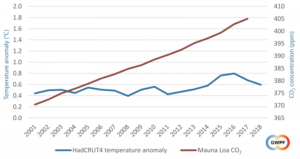by David Whitehouse, February 7, 2019 in GWPF
Average global temperature has been falling for the last 3 years, despite rising atmospheric CO2 levels.

2018 was the fourth warmest year of the instrumental period (started 1850) having a temperature anomaly of 0.91 +/- 0.1 °C – cooler than 2017 and closer to the fifth warmest year than the third. But of course there are those that don’t like to say the global surface temperature has declined.
…
by Charles the moderator, February 7, 2019 in WUWT
Study shows that Vikings enjoyed a warmer Greenland
Chemistry of bugs trapped in ancient lake sediment shows a warm climate at a key time in Greenland’s history
Although TV and movies paint Vikings as robust souls, braving subzero temperatures in fur pelts and iron helmets, new evidence indicates they might have been basking in 50-degree summer weather when they settled in Greenland.
After reconstructing southern Greenland’s climate record over the past 3,000 years, a Northwestern University team found that it was relatively warm when the Norse lived there between 985 and 1450 C.E., compared to the previous and following centuries.
…
by Steve Goreham, February 7, 2019 in WUWT
When Thomas Edison established his Pearl Street power plant in New York City in 1892, he used coal for fuel, not wood. Wood fuel could not compete with the cost of coal in 1892 and it still can’t today. Nevertheless, burning of biomass is widely regarded as sustainable and promoted as a solution for climate change, especially in Europe.
Today, Europe produces about 17 percent of its energy and 29 percent of its electricity from renewable sources. Biomass accounts for about 19 percent of the electricity generated from renewables. Since 2000, Europe’s biomass consumption for energy production is up 84 percent.
For example, biomass fuel produced 18 percent of Denmark’s electricity in 2017. For the last two decades, Denmark has been reducing coal-fired power plant output, but adding biomass-powered plants. Since 2000, Denmark’s use of coal fuel for electricity decreased 63 percent. But the use of biomass fuel for electricity in Denmark increased by a factor of five, almost exactly replacing the decline in coal output. About three-quarters of the biomass consumed by Denmark is wood, with most of it imported.
…
by Marc Morano ,February 6, 2019 in ClimatDepot
Another year, another claim of “hottest” or “warmest years.” So-called “Hottest year” claims are purely political statements designed to persuade the public that the government needs to take action on man-made climate change. Once again, the media and others are hyping temperature changes year-to-year so small as to be within the margin of error.
Such temperature claims are based on year-to-year temperature data that differs by only a few hundredths of a degree to up to a few tenths of a degree—differences that were within the margin of error in the surface data.
Here are the AP’s and NASA’s claims out today: (A full debunking of these “hottest year”claims follows below.)
…
La géologie, une science plus que passionnante … et diverse

